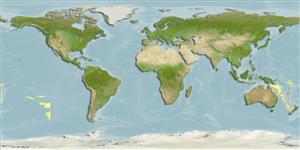Пластиножаберные (акулы и скаты) (sharks and rays) >
Squaliformes (Sleeper and dogfish sharks) >
Squalidae (Dogfish sharks)
Etymology: Squalus: Genus name from Latin 'squalus' meaning shark (Ref. 6885, 27436); notocaudatus: Name from Latin 'nota' for mark and 'cauda' for tail, referring to the dark bar on the caudal fin.
More on authors: Last, White & Stevens.
Environment: milieu / climate zone / depth range / distribution range
экология
морской; пределы глубины 225 - 454 m (Ref. 58440). Tropical
Western Pacific: Queensland, Australia.
Size / Вес / Возраст
Maturity: Lm ? range ? - ? cm
Max length : 61.9 cm TL самец/пол неопределен; (Ref. 58440)
Краткое описание
определительные ключи | морфология | морфометрия
This species in the 'highfin megalops group' is distinguished by the following set of characters: abdomen depth 8.6-11.1% TL; pre-vent length 45.3-46.5% TL, 1.9-2.0 times dorsal caudal margin; pre-second dorsal length 3.6-4.0 times pectoral-fin anterior margin, 2.4-2.6 times dorsal caudal margin; head width 1.4-1.6 times abdomen width; preoral length 2.8-3.2 times the horizontal prenarial length, 8.4-9.5% TL; head length 3.8-4.3 times its eye length;
mouth width 3.4-4.3 times the length of upper labial furrow; interorbital width 1.4-1.5 times the horizontal preorbital length; fifth gill slit height 1.9-2.1% TL; strongly bifurcated anterior nasal flap; first dorsal fin upright, upper posterior margin almost vertical, greatest concavity closer to free rear tip than fin apex; posterior margin of second dorsal fin deeply concave; second dorsal-fin spine with a broad base; pectoral fin of adult weakly falcate, anterior margin long, 14.6-16.4% TL; both dorsal and ventral surfaces are pale; dorsal fins pale with obvious dark
tips; first dorsal-fin spine and base of soft portion of dorsal fin both pale; caudal fin with broad white posterior margin; prominent dark, diagonal subterminal streak parallel to the upper posterior margin; flank denticles strongly tricuspid; monospondylous centra 47-49, precaudal
centra 94-97, total centra 123-127 (Ref. 58440).
Life cycle and mating behavior
половая зрелость | размножение | нерест | икра | Fecundity | личинки
Distinct pairing with embrace (Ref. 205).
Last, P.R., W.T. White and J.D. Stevens, 2007. New species of Squalus of the 'highfin megalops group' from the Australasian region. p. 39-53. In P.R. Last, W.T. White and J.J. Pogonoski Descriptions of new dogfishes of the genus Squalus (Squaloidea:Squalidae). CSIRO Marine and Atmospheric Research Paper No. 014. 130 p. (Ref. 58440)
Статус Красного Списка МСОП (Ref. 130435: Version 2024-2)
Угроза для людей
Harmless
Использование человеком
рыболовство: потенциальный рыбохозяйственный объект
дополнительная информация
инструменты
Специальные отчеты
Скачать в формате XML
ресурсы в Интернет
Estimates based on models
Preferred temperature (Ref.
123201): 8.7 - 17.5, mean 13 °C (based on 25 cells).
Phylogenetic diversity index (Ref.
82804): PD
50 = 0.5000 [Uniqueness, from 0.5 = low to 2.0 = high].
Bayesian length-weight: a=0.00347 (0.00165 - 0.00730), b=3.09 (2.92 - 3.26), in cm total length, based on LWR estimates for this Genus-body shape (Ref.
93245).
Trophic level (Ref.
69278): 4.2 ±0.3 se; based on size and trophs of closest relatives
устойчивость к внешним воздействиям (Ref.
120179): низкий, минимальное время удвоения популяции 4.5-14 лет (Preliminary K or Fecundity.).
Fishing Vulnerability (Ref.
59153): Moderate vulnerability (45 of 100).
